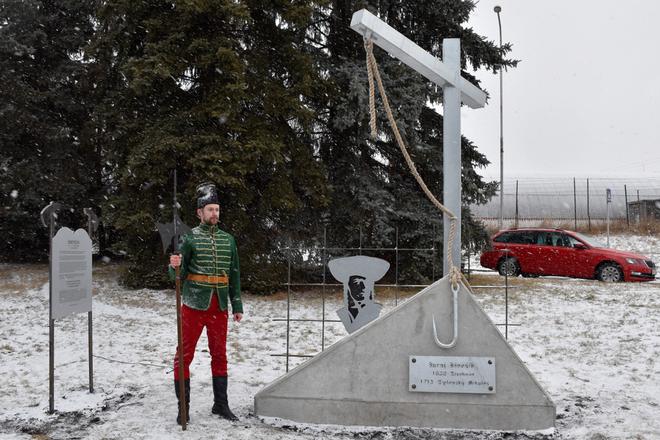There are many stories and places linked to the controversial Juraj Jánošík, a Slovak hero to some and an outlaw to others, but the exact place where he was sent to the gallows remains a mystery.
 Find out more about region of folklore, national parks and modern attractions in our Žilina Region Travel Guide. (source: Spectacular Slovakia)
Find out more about region of folklore, national parks and modern attractions in our Žilina Region Travel Guide. (source: Spectacular Slovakia)
Born in 1688, the Terchová native went on trial for his crimes and hung on a hook at the Šibeničky execution site in Liptovský Mikuláš on March 17, 1713. The town has recently installed a gallows replica made of steel in a place that is believed to be the site where the actual Šibeničky gallows once stood.
“Everyone knows where Jánošík was born and where he was arrested, but unlike the place of his imprisonment, the location of Jánošík’s execution has not yet been presented,” said Liptovský Mikuláš mayor Ján Blcháč. The outlaw was jailed in a manor house in Palúdzka, now one of the town’s boroughs.
Liptovský Mikuláš, which lies next to the Liptovská Mara water dam and is a stone’s throw away from the mountains, decided to place its new site 2.5 kilometres east of the historical centre, opposite the Liptov Dairy.
Reconciliation
“The execution of the folk hero is not to be bragged about, but it was part of the history of our town,” the mayor said, defending the attraction.
The new black-and-silver gallows feature several symbolic pieces that represent the Kriváň peak and the parchment with his sentence, to name a few. The site was constructed by designer Stanislav Machovčák and painter Miroslav Michálek. In the town, tourists can also find the Jánošík torture chamber in the underground of the Janko Kráľ Museum.

Blcháč went on to say that the citizens of Liptovský Mikuláš publicly apologised to Terchová residents for the execution of Jánošík in 2018. Terchová, situated in the Orava region, accepted the apology. A plaque next to the gallows, resembling an open book, symbolises this act of reconciliation between the two towns.
Šibeničky
Jánošík is said to have been executed in the eastern part of the town, in between Liptovský Mikuláš and Okoličné, another one of the town’s boroughs today, Katarína Verešová of the Janko Kráľ Museum claimed.
She added that the execution site, Šibeničky, was built in an elevated place so that the convicts could be seen from a distance. In the past, three trees marked the site, which grew here until the mid-20th century.
“Šibeničky was still used as the execution site at the beginning of the 19th century,” the museum worker said, “when the outlaw Matej Tatarka was the last to be executed here.”
Spectacular Slovakia travel guides
A helping hand in the heart of Europe thanks to the Slovakia travel guide with more than 1,000 photos and hundred of tourist spots.
Detailed travel guide to the Tatras introduces you to the whole region around the Tatra mountains, including attractions on the Polish side.
Lost in Bratislava? Impossible with our City Guide!
See some selected travel articles, podcasts, traveller's needs as well as other guides dedicated to Nitra, Trenčín Region, Trnava Region and Žilina Region.



 A gallows replica is the latest tourist attraction in Liptovský Mikuláš, where Juraj Jánošík was executed in 1713. (source: Miroslava Mlynárová/TASR)
A gallows replica is the latest tourist attraction in Liptovský Mikuláš, where Juraj Jánošík was executed in 1713. (source: Miroslava Mlynárová/TASR)
 The base of the site symbolises the Kriváň peak. (source: Miroslava Mlynárová/TASR)
The base of the site symbolises the Kriváň peak. (source: Miroslava Mlynárová/TASR)